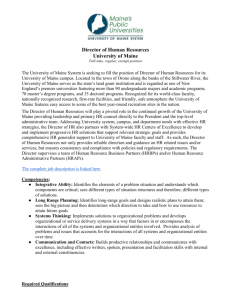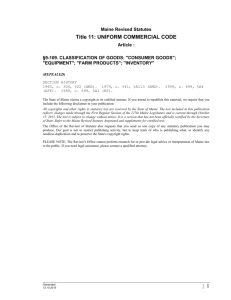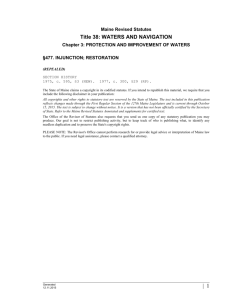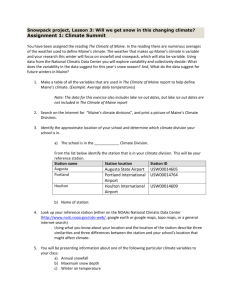windmills & climate doc
advertisement
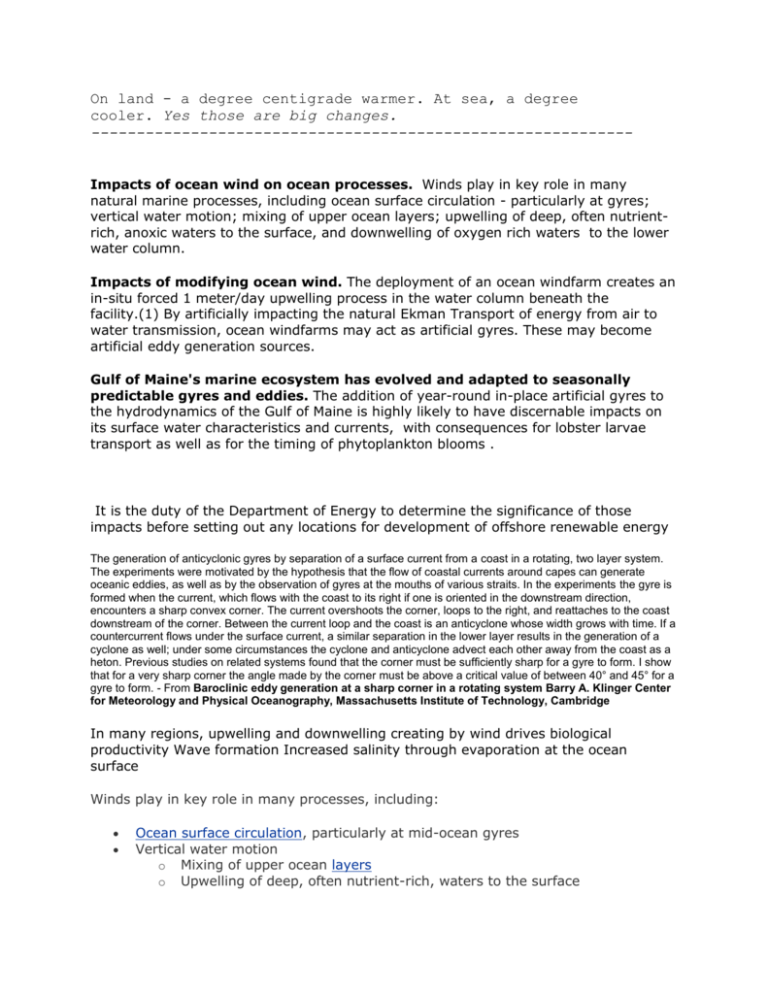
On land - a degree centigrade warmer. At sea, a degree cooler. Yes those are big changes. -----------------------------------------------------------Impacts of ocean wind on ocean processes. Winds play in key role in many natural marine processes, including ocean surface circulation - particularly at gyres; vertical water motion; mixing of upper ocean layers; upwelling of deep, often nutrientrich, anoxic waters to the surface, and downwelling of oxygen rich waters to the lower water column. Impacts of modifying ocean wind. The deployment of an ocean windfarm creates an in-situ forced 1 meter/day upwelling process in the water column beneath the facility.(1) By artificially impacting the natural Ekman Transport of energy from air to water transmission, ocean windfarms may act as artificial gyres. These may become artificial eddy generation sources. Gulf of Maine's marine ecosystem has evolved and adapted to seasonally predictable gyres and eddies. The addition of year-round in-place artificial gyres to the hydrodynamics of the Gulf of Maine is highly likely to have discernable impacts on its surface water characteristics and currents, with consequences for lobster larvae transport as well as for the timing of phytoplankton blooms . It is the duty of the Department of Energy to determine the significance of those impacts before setting out any locations for development of offshore renewable energy The generation of anticyclonic gyres by separation of a surface current from a coast in a rotating, two layer system. The experiments were motivated by the hypothesis that the flow of coastal currents around capes can generate oceanic eddies, as well as by the observation of gyres at the mouths of various straits. In the experiments the gyre is formed when the current, which flows with the coast to its right if one is oriented in the downstream direction, encounters a sharp convex corner. The current overshoots the corner, loops to the right, and reattaches to the coast downstream of the corner. Between the current loop and the coast is an anticyclone whose width grows with time. If a countercurrent flows under the surface current, a similar separation in the lower layer results in the generation of a cyclone as well; under some circumstances the cyclone and anticyclone advect each other away from the coast as a heton. Previous studies on related systems found that the corner must be sufficiently sharp for a gyre to form. I show that for a very sharp corner the angle made by the corner must be above a critical value of between 40° and 45° for a gyre to form. - From Baroclinic eddy generation at a sharp corner in a rotating system Barry A. Klinger Center for Meteorology and Physical Oceanography, Massachusetts Institute of Technology, Cambridge In many regions, upwelling and downwelling creating by wind drives biological productivity Wave formation Increased salinity through evaporation at the ocean surface Winds play in key role in many processes, including: Ocean surface circulation, particularly at mid-ocean gyres Vertical water motion o Mixing of upper ocean layers o Upwelling of deep, often nutrient-rich, waters to the surface In many regions, upwelling drives biological productivity Downwelling of surface, often oxygen-rich, waters Wave formation Increased salinity through evaporation at the ocean surface o Ekman Transport is the natural process by which wind causes movement of water near the ocean surface. Each layer of water in the ocean drags with it the layer beneath. Thus the movement of each layer of water is affected by the movement of the layer above (or below in the case of a frictional bottom boundary layer such as -----------------------------------------------------------Bureau of Parks and Lands Certified Record in Huber v. BPL wind test area lawsuit. The official record submitted to Maine Superior Court on May 13, 2010: http://penbay.org/monhegan/court/monhegan_record.html Potential climatic impacts and reliability of very large-scale wind farms. 3/12/2010 http://globalchange.mit.edu/pubs/abstract.php?publication_id=2047 MIT News release about the above report Excerpt: " Using wind turbines to meet 10% or more of global energy demand in 2100, could cause surface warming exceeding 1 °C over land installations. In contrast, surface cooling exceeding 1 °C is computed over ocean installations, but the validity of simulating the impacts of wind turbines by simply increasing the ocean surface drag needs further study. " * : Could Windmills Alter the Weather? Meteorology News 2009 Excerpt: "A team of researchers from the University of Maryland have found that large-scale use of wind turbines as a power source may have an impact on our environment directly opposite that which they purport to minimize: Climate change." Research of Windfarm-Climate Interactions. University of Maryland researchers mentioned above Excerpts: "Recent work on the climate impact of very large scale wind farms has demonstrated appreciable effects on surface temperature, including warming and cooling on the order of a degree Celsius"....."These results show a zonal pattern suggestive of a reduction in meridional heat transport."...."... The patterns of warming and heating seemed most related to changes in wind direction, resulting in advective heating and cooling, and in changes in cloud fraction that influenced solar heating patterns"..."These experiments show a significant remote influence of large scale roughness changes on synoptic scale winds. My graduate student Dan Barrie and I are now exploring the influence of time-varying surface roughness on downstream storm tracks." . * Windmills at sea will affect the climate Goram Brostrom, Norwegian Meteorology Institute. 2008 (note this is a google translation from Norwegian. Excerpt: "A new study from the Norwegian Meteorological Institute has shown that a wind farm that provides an impact on the wind field at the same time will provide a powerful impact on the local ocean currents, and probably on the amount of phytoplankton that can grow in the ocean. Windmill parks will affect the wind field over an area much larger than the parks themselves, and the effects on the ocean will also apply to an area much larger than the size of the park." On the influence of large wind farms on the upper ocean circulation. Goram Brostrom, Norw. Meteorology Institute.2008 Excerpt: "We show through simple analytical models and idealized numerical experiments that a wind speed of 5–10 m/s may generate upwelling/downwelling velocities exceeding 1 m/day if the characteristic width of the wind wake is of the same size or larger than the internal radius of deformation. The generated upwelling is sufficiently enough that the local ecosystem will most likely be strongly influenced by the presence of a wind farm." On the influence of large wind farms on the upper ocean circulation. Goram Brostrom, Norw. Meteorology Institute.2008 Excerpt: "We show through simple analytical models and idealized numerical experiments that a wind speed of 5–10 m/s may generate upwelling/downwelling velocities exceeding 1 m/day if the characteristic width of the wind wake is of the same size or larger than the internal radius of deformation. The generated upwelling is sufficiently enough that the local ecosystem will most likely be strongly influenced by the presence of a wind farm." Potential climatic impacts and reliability of very large-scale wind farms. 3/12/2010 http://globalchange.mit.edu/pubs/abstract.php?publication_id=2047 MIT News release about the above report Excerpt: " Using wind turbines to meet 10% or more of global energy demand in 2100, could cause surface warming exceeding 1 °C over land installations. In contrast, surface cooling exceeding 1 °C is computed over ocean installations, but the validity of simulating the impacts of wind turbines by simply increasing the ocean surface drag needs further study. " * : Could Windmills Alter the Weather? Meteorology News 2009 Excerpt: "A team of researchers from the University of Maryland have found that large-scale use of wind turbines as a power source may have an impact on our environment directly opposite that which they purport to minimize: Climate change." Research of Windfarm-Climate Interactions. University of Maryland researchers mentioned above Excerpts: "Recent work on the climate impact of very large scale wind farms has demonstrated appreciable effects on surface temperature, including warming and cooling on the order of a degree Celsius"....."These results show a zonal pattern suggestive of a reduction in meridional heat transport."...."... The patterns of warming and heating seemed most related to changes in wind direction, resulting in advective heating and cooling, and in changes in cloud fraction that influenced solar heating patterns"..."These experiments show a significant remote influence of large scale roughness changes on synoptic scale winds. My graduate student Dan Barrie and I are now exploring the influence of time-varying surface roughness on downstream storm tracks." . * Windmills at sea will affect the climate Goram Brostrom, Norwegian Meteorology Institute. 2008 (note this is a google translation from Norwegian. Excerpt: "A new study from the Norwegian Meteorological Institute has shown that a wind farm that provides an impact on the wind field at the same time will provide a powerful impact on the local ocean currents, and probably on the amount of phytoplankton that can grow in the ocean. Windmill parks will affect the wind field over an area much larger than the parks themselves, and the effects on the ocean will also apply to an area much larger than the size of the park." See: http://www.penbay.org/monhegan/rmonhegan_foa_reply_011410/monh07_md oc_designation_01.html 1. Lobster Cove is a Scenic Resource of State and National Significance as defined by Title 35-A, section 3451, subsection 9. 2. The scenic resources of Lobster Cove are Protected Natural Resources. 3. The Bureau of Parks and Lands and the Maine State Planning Office have failed to protect these lands Impacts of artificially A theory of the atmospheric disturbance caused by a large wind farm is developed using a simple boundary layer (BL) representation. The model includes pressure gradients and gravity wave generation associated with a temperature inversion at the top of the BL and the normal tropospheric lapse rate aloft. The pattern of wind disturbance is computed using a Fast Fourier Transform. The slowing of the winds by turbine drag and the resulting loss of wind farm efficiency is controlled by two factors. First is the size of the wind farm in relation to the restoring effect of friction at the top and bottom of the BL. Second is the role of static stability and gravity waves in the atmosphere above the BL. The effect of the pressure perturbation is to decelerate the wind upstream and to prevent further deceleration over the wind farm with a favorable pressure gradient. As a result, the wind speed reduction is approximately uniform over the wind farm. In spite of the uniform wind over the farm, the average wind reduction is still very sensitive to the farm aspect ratio. In the special case of weak stability aloft, weak friction and the Froude Number the wind speed near the farm can suddenly decrease; a phenomenon we call ‘choking’. Copyright © 2009 John Wiley & Sons, Ltd. Brostrom 2008 noted that "Large wind farms exert a significant disturbance on the wind speed in the vicinity of the installation and in this study we outline the oceanic response to the wind wake from a large wind farm placed in the ocean. We find. ...that a wind speed of 5–10 m/s may generate upwelling/ downwelling velocities exceeding 1 m/day if the characteristic width of the wind wake is of the same size or larger than the internal radius of deformation. The generated upwelling is sufficiently enough that the local ecosystem will most likely be strongly influenced by the presence of a wind farm. At a minimum, DOE will evaluate the potential impacts that may result to biological resources, water resources, the acoustic environment, ocean use, including commercial fisheries and recreation, aesthetics, socioeconomics & cultural resources, and will develop a reasonable range of alternatives. We have reviewed data compiled to date by the State of Maine and the University of Maine in support of the deepwater wind test center proposal off Monhegan Island We ahve also obtained information from naturalists familiar with the birds and other life of the area, as well as from oceanographers familiar with both existing currents of the area of the Gulf of Maine of interest to this Department, and with the possible changes that deployment of the deepwater floating wind turbines could have on these resources. We note that, while not mentioned specifically in the public notice, in addition to production and deployment of a one third sized prototype windmill, the Department of Energy's funding is directed to development of a fully operational 5 megawatt deepwater wind turbine, according to Elizabeth Viselli of the DeepCWind Consortium, who noted recently that in the past year DeepCwind " "has been awarded nearly $40 million in funding to pursue research in deepwater offshore wind energy technology." Very little of the environmental and ecological data compiled by the state of Maine in support of its deepwater wind test center off Monhegan, however, will apply to the full scale turbine's placement and operation in waters distant from the Monhegan Deepwater Test Center. Yet at least one full sized floating wind turbine, and a series of both additional prototypes and additional full sized floating wind turbines are reasonably likely outcomes of this funding decision by the Department of Energy. It is our position that a large number of uncertainties remain as to the project's direct and offsite impacts. There is a strong likelihood of induced significant direct impacts to protected and managed resources in connection with additional federal ocean wind leasing activities proposed recently for federal waters off Maine. We strongly believe that the degree of uncertainty about the severity of these impacts warrants preparation of an Environmental Impact Statement. Recent findings by European and American ocean windfarm researchers, detailed below, show significant changes to ocean current flows and water temperatures due to the waste energy discharges that are endemic to ocean windmill operation. ------------------------------------------------------------ We ask the Department of Energy to incorporate and consider the following issues and facts pertaining to the proposed deployment and operation of at least one prototype one-third size wind turbine within the Monhegan Deepwater Wind Test Center, followed by deployment of at least one utility scale floating wind turbine farther offshore. * Identify any adverse environmental effects that cannot be avoided should this proposed project be implemented. * Evaluate viable alternatives to the proposed project. * Describe the relationship between local short-term uses of the environment and the maintenance and enhancement of long-term productivity. * Characterize any irreversible and irretrievable commitments of resources that would be involved should this proposed project be implemented. We ask that the DOE consider as broad a geographic scope as possible. 1. Impacts to both the two square mile footprint of the demonstration test site and to the ill-defined but foreseeable footprint of the site farther offshore where the full-sized floating wind turbine will be deployed as part of this expenditure of DOE funds. 2. Impacts to the Eastern Maine Coastal Current, the Western Maine Coastal Current and other existing oceanographic structure of the Gulf of Maine that will be impacted by deployment of the test and full sized floating turbines. 3. Impacts to Gulf of Maine lobster larvae migration from alterations in existing Gulf of Maine current dynamics caused by deployment of floating deepwater wind turbines in hydrodynamically sensitive areas. 4 Impacts to Gulf of Maine nutrient flows and to overall seasonally significant geographic concentrations of finfisheries, due to alterations in existing Gulf of Maine current dynamics and alterations in thermal structure of the water column of the footpring of floating deepwater turbines. 5. Impacts to irreplaceable scenic resources of state and national significance from deploying this test project off of Monhegan Island, as opposed far lesser impacts from deploying in one of the other two locations chosen by the state of Maine as deepwater test areas, but relegated to later development, if at all. 6. Impacts to Atlantic puffins and other seabirds known and documented to overfly the area of the proposed wind test site off Monhegan. 7. Impacts to land birds known and documented as serasonally migrating through the location off Monhegan proposed for the University of Maine's deepwater wind site direct and indirect, short term and cumulative, onsite and offsite Category 1. (DOE/EA 1792) Notice of Scoping ________________________________________ Scoping period extended until October 18, 2010 September 20, 2010 To: Distribution List SUBJECT: Notice of Scoping - University of Maine Deepwater Offshore ‘Wind Test Site, Gulf of Maine The U.S. Department of Energy (DOE) is proposing to award federal funding to the University of Maine (U Maine) to construct, deploy. and retrieve 1//3-scale floating wind turbines within the deepwater offshore wind test site (project) in the Gulf of Maine approximately two miles south of Monhegan island. Details of the proposed project and its location are contained in the attachment to this Scoping Notice. Additional project information can be found at the U Maine DeepCwind Consortium website: http://www.deepcwind.org. Pursuant to the requirements of the National Environmental Policy Act (NEPA), the Council on Environmental Quality regulations for implementing the procedural provision of NEPA (40 CFR Parts i500-1508). and DOE’s implementing procedures for compliance with NEPA (l0 CPR 102]), DOE is preparing a draft Environmental Assessment (EA) to: * Identify any adverse environmental effects that cannot be avoided should this proposed project be implemented. * Evaluate viable alternatives to the proposed project. * Describe the relationship between local short-term uses of the environment and the maintenance and enhancement of long-term productivity. * Characterize any irreversible and irretrievable commitments of resources that would be involved should this proposed project be implemented. Potential Environmental Effects or Issues Identified for the Environmental Assessment The EA will describe and analyze any potential impacts on the environment that would be caused by the project and will identify possible mitigation measures to reduce or eliminate those impacts. At a minimum, DOE will evaluate the potential impacts that may result to: * Biological Resources, including avian species, bats, and marine mammals * Water Resources * The Acoustic Environment * Ocean Use, including commercial fisheries and recreation * Aesthetics Socioeconomics Cultural Resources Development of a Reasonable Range of Alternatives DOE is required to consider a reasonable range of alternatives to the proposed action during an environmental review. The definition of alternatives is governed by the “rule of reason”. An EA must consider a reasonable range of options that could accomplish the agency’s purpose and need while reducing environmental effects. Reasonable alternatives are those that may be feasibly carried out based on environmental, technical. and economic factors. The No Action Alternative will be addressed. The need for project redesign, or a project alternative, will be determined during the course of environmenta] review. Public Scoping The DOE is making this letter available to interested federal, state, and local agencies to provide information on issues to be addressed in the EA. Agencies are invited to identify the issues within their statutory responsibilities that should be considered in the EA. The general public is also invited to submit comments on the scope of the EA. This letter and the draft EA, when it is available, will be posted in the DOE Golden Field Office online reading room: http://www.eere.energy.govfgoldenfReading_Roomaspg. The DOE Golden Field Office welcomes your input throughout our NEPA process. Please submit your comments by October 5. 2010 to: Department of Energy Golden Field Office NEPA Division Attn: Kurt Rautenstrauch 116117 Cole Boulevard Golden, Colorado 80403 Or via email to: Kurt.Rautenstrauch@go.doe.gov Thank you for your participation in the NEPA process Lobster larvae flow images http://rocky.umeoce.maine.edu/lob-02/02stage15-1m.htm http://rocky.umeoce.maine.edu/synthesis_lobster.html Visualization of lobster larvae migration in the Gulf of Maine Natasha Kellaway, Dept computer science Wellesley College Mass. Steve Cousins, Dr Fei Chai, Dr Huijie Xue Ocean Modeling Group, UMaine http://arch.eece.maine.edu/superme/images/7/79/Mid-report-final.pdf nkellawa@wellesly,edu cousins@umit.maine.edu hxue@maine.edu fchai@maine.edu Abstract. A valuable tool in assessing migration of a large amount of creatures is to visualize simulation data. Simulation data has already been collected for the migration of lobster larvae in the Gulf of Maine. The visualization of this data will provide a way to see the effects of the currents on the lobster larvae in different regions of the Gulf of Maine. This paper outlines a methodology and series of code developed to visualize this simulation data BDN story October 2009 By comparison, the entire U.S. coastline has about 1,500 gigawatts of offshore wind potential in waters deeper than 60 meters within 50 nautical miles of its shores, Dagher has said.The Department of Energy has a stated goal of achieving 20 percent of the nation’s electricity from wind power by the year 2030. Gov. John Baldacci said Thursday Maine’s goal is to generate 5 gigawatts of power by 2030. Dagher said 1 gigawatt is roughly equivalent to the energy output of one nuclear power plant. Five gigawatts of power, which is 3 percent of the energy potential of the Gulf of Maine within 50 miles of shore, would be enough to attract roughly $20 billion in related investment, according to Dagher.The Department of Energy grant is also expected to lead to job growth in Maine, Dagher said. Initially, UMaine will hire students, scientists and some faculty for research, development, production and deployment of the technology. Page 15 of this is about Maine task force plan. http://www.necanews.org/dev/documents/100303_labelle_robert_3.pdf http://www.pnas.org/content/101/46/16115.full Fish and sessile assemblages associated with wind-turbine constructions in the Baltic Sea Mathias H. Andersson A B and Marcus C. Öhman A. A Department of Zoology, Stockholm University, S-106 91 Stockholm, Sweden. B Corresponding author. Email: mathias.andersson@zoologi.su.se Offshore Windmills and the Effects of Electromagnetic Fields on Fish Marcus C. Öhman, Peter Sigray, Håkan Westerberg AMBIO: A Journal of the Human Environment 36(8):630-633. 2007 http://www.publish.csiro.au/?paper=MF09117 Request for Interest in Renewable Energy Leasing Offshore Maine http://www.boemre.gov/offshore/RenewableEnergy/PDFs/stateactivities/ME_m eeting/METFmeetingRFIIntro.pdf Coastal Impact Assistance Program (CIAP) Part of the Energy Policy Act of 2005 (Public Law 109-58 Coastal Impact Assistance Program (CIAP) Part of the Energy Policy Act of 2005 (Public Law 109-58 http://www.boemre.gov/offshore/CIAPmain.htm OCEANA http://green.blogs.nytimes.com/2010/09/28/never-mind-oil-group-says-thinkatlantic-wind/?hp Offshore wind Wire http://www.wind-watch.org/news/2010/10/04/offshore-wind-faces-uphill-climb/ Offshore Wind Wire: Report says offshore wind http://offshorewindwire.com/2010/09/29/roundup-offshore-wind-could-supplyhalf/ Wind Power Maine http://www.windforme.org/ CLIMATE “Potential climatic impacts and reliability of very large-scale wind farms” by C. Wang and R. G. Prinn http://www.atmos-chem-phys-discuss.net/9/C6936/2009/acpd-9-C6936-2009print.pdf UPWELLING http://www.gmri.org/community/seastate/Churchill_Jim/Churchill_Jim.pdf Large Upwelling Systems of the World http://www.euroceans.info/EN/education/malette/eng/fichiers_pdf_anglais/mate/Upwelling%20 ecosystems.pdf CABLES IMPACTS Magnetic Attraction for Fish, Crabs? http://www.newswise.com/articles/view/568602/?sc=swhn ATLANTIC STATES http://www.thefreelibrary.com/International+efforts+to+protect+marine+biodive rsity+through+marine...-a081829319 http://www.nero.noaa.gov/hcd/10highlights/MayJune10.pdf Experts to discuss future of wind energy next week in Atlantic City http://pressofatlanticcity.com/news/press/new_jersey/article_6a67809a-cd9b11df-9227-001cc4c002e0.html http://www.mdcoastdispatch.com/article.php?cid=37&id=9646 PLANKTON Exploring Fine Scale Ecology for Groundfish in the Gulf of Maine and Georges Bank http://www.gmri.org/community/display.asp?a=5&b=14&c=160 http://www.gmri.org/community/seastate/Industry_Panel/Integrating_GIS_and_ Qualitative_Research_Methods.pdf http://www.gmri.org/community/seastate/Churchill_Jim/Churchill_Jim.pdf http://penbay.org/wind/ocean/gom_currents.jpg BIRDS http://sites.google.com/site/mainebirdrecordscommittee/About-ME-BRC FOREIGN UK policy shift may hit offshore wind boom: Statoil http://www.reuters.com/article/idUSLDE68R1RF20100928 Wind Liberation https://sites.google.com/site/windliberation/ EUROPE Horns Rev http://www.vattenfall.com/en/file/horns-rev-offshore-wind-farm_8459975.pdf
